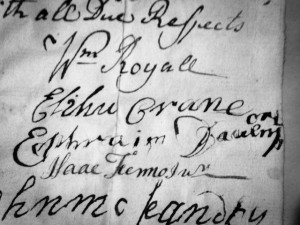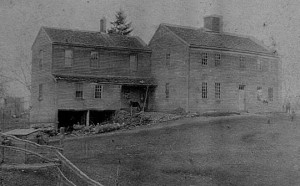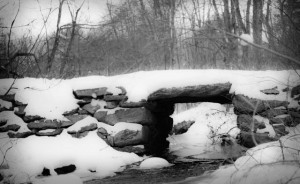True Tales from Canton’s Past: Packeen Ghost
By George T. ComeauThis story was reprinted in the October 15, 2020 edition of the Citizen.
The voice was human. Deep within the woods of the Fowl Meadow, the cries could be heard — melancholy crying that was supernatural and from another world. Indeed, the sounds that came from the Packeen Plain in 1770 were far beyond the laws of nature.
There are only two ghost stories that have been passed down through the history of Canton, and of the two the Packeen Ghost is the most celebrated. Verified by so many townspeople, the spirit that possessed the woodland and swamps of the Fowl Meadow captivated the small colonial community for months on end, as unknown crying sounds terrified the town.
Looking back to the year of 1770 in the handwritten Town Warrants, we see a simpler time where the questions before the town were as straightforward as “whether to allow swine to go at large the year ensewing,” or what amount to set upon the heads of rattlesnakes and crows. To further frame the period, there were less than 315 dwellings and about 2,000 people in total in what today is Canton and Stoughton. Dealing with a ghost was not something that our colonial ancestors were used to, and perhaps superstition had a free hand.
The area where the spirit roamed was called Packeen. An ancient area of the town that no longer exists, Packeen was a fertile hill that gently descended over several miles to the boundaries of Dedham. The area today would be that section below Washington and Dedham streets extending across the Fowl Meadow and the Neponset River to Signal Hill. The Packeen Plain was the second area of the town to be developed after the Ponkapoag settlement. In the Dorchester records the name Packeen appears in 1707. This early record is the point at which the boundaries of Dorchester begin to be broken off: “The land belonging to Dorchester beyond the Blue Hills should be called by the name of Dorchester New Grant.”
Many of Canton’s earliest records trace back to the “Dorchester New Grant.” The map of this area is exceedingly large and described as a precinct “as far as Mashapoag Pond and Moose Hill, and ye Meetinghouse ordered to be sett upon Packeen Plain.” That meetinghouse was likely where the Canton Corner Cemetery is today, and in olden days a perfect view could be had across the meadows clear to Dedham. That was the “plain,” the high and flat spot that gradually descended to the Fowl Meadows.
The name Packeen was the Indian place name for this area, and no definition has been found as a translation. Today the only remnant of the use of this name is that of the Pakeen Farm on Elm Street. Crossing that ancient tract of land is a long lost road that ascends up from perhaps the oldest stone bridge in Canton, and it was at one time named Packeen Road. The noted Canton historian Daniel Huntoon writes in the late 1800s, “The name Packeen has gradually and imperceptibly been transferred from its original location, to a more westerly part of town, the memory of the oldest inhabitant, recalls the name only in connection with that territory lying between Dedham Road, Pecunit Street, and the Fowl Meadows.”
This district of town was sparsely populated. In 1774, 15 residents petitioned for a separate school, and by 1783 they were allowed to build a small schoolhouse. From 1796 through 1832 the Packeen Schoolhouse was located in the Pecunit Valley “on the margin of Pecunit Brook.” Also known as Bailey’s Branch No. 6, the original building was sold for “two pairs of boots.” Henry Withington built the second school in 1806, and in 1838 it too was disposed of and was moved to become a woodshed attached to the house of James Draper. Indeed, this area of our town has a rich and colorful history beyond this ghost tale.

The signature of Deacon Elihu Crane, who performed the exorcism of the Packeen Ghost (Courtesy of the Canton Historical Society)
Today, Packeen Road is long gone, yet remnants of it are likely Elm Street to where it intersects with Dedham Street. Portions of it are likely still on the private property of the Lyman family’s Pakeen Farm. At one time, before the construction of Route 128, this road extended to Green Street and into Milton. And this is where our ghost story picks up — at the house of Deacon Elihu Crane. If you drive down Royall Street, almost to the end of the street on your left is a small stub of Green Street, and there is an ancient Federal-style house, the home of General Nathan Crane, Elihu Crane’s son. The deacon’s homestead, forever lost, was across the street from the surviving colonial era house.
As the cries from the watery marsh struck fear in the hearts of men, they implored the deacon to exorcise the demon from their midst. Deacon Crane stood fast and was not willing to deal with the issue. For months the wailing continued, and more and more men stepped forward corroborating to the circumstance that this wailing was indeed a spirit from another world.
Henry Crane, Preserved Lyon and Joseph Aspinwall each attested to the fact that the voice they heard was “human, but at the same time so weird and melancholy in its tone that it sent a chill of horror through the listener.” Three of the most upstanding men had all heard the wails in the night and their testimony was unimpeachable.
Aspinwall in particular was a most credible man, described as “a staunch old church man.” Born in 1698, Aspinwall came from Dedham and was a loyal follower of the King of England. Inhabiting the area near Pecunit and Elm streets, Aspinwall was the first settler of this part of town. On his gravestone in the Old English Burying Ground is engraved, “To the font carried, at the rail married, and then a mound.” Together with Crane and Lyon, Aspinwall described the cries in the darkness as “something between the wail of a woman and the cry of a catamount.”
Within months, more leaders of the community stepped forward with fear and nervousness. Edward Downes, John Taunt and William Crane II spoke of the sound as “a lost soul crying in the wilderness.” As darkness descended on the Neponset River, Isaac Billings, the ferryman, never put his boat across the ferry after sunset for fear of the Packeen Ghost. The sounds were unearthly, and to deal with anything unearthly called for the intervention of the church. Once again, Deacon Crane was called upon.
After much persuasion the deacon willingly placated his neighbors and undertook the task of exorcising the spirit. Bundling his woolen cloak pulled close to his face against the autumn wind, Deacon Crane left his house with his bible clutched to his breast. Alone, the deacon crossed the Stone Bridge with icy water flowing across and into the meadows. Deep in the woods, in the area reputedly frequented by “his ghostship,” the deacon at last found a desolate clearing and undertook the task of an exorcism.
A distant bell tolled midnight as Deacon Crane began his work. Under the hunter’s moon a long golden light flooded the glade, and with a wonderfully powerful voice the deacon began. It is said that the residents of Tiot, in South Dedham, and Clapboard Trees, West Dedham, could have heard the deacon’s voice cutting through the frosty air. “I know,” exclaimed the deacon, “O unknown one, that thou art neither flesh and blood nor mortal in any way or shape. I pray thee no longer leave the pale realms of shade to haunt the regions of this earth.”

The House of Isaac Billings, the ferryman who refused to cross the Neponset River for fear of the Packeen Ghost (Courtesy of the Canton Historical Society)
The wind picked up, and dry brittle leaves swirled in a maelstrom around the wizened deacon. Raising his voice even louder, he implored the spirit to “leave, then, the Fowl Meadows, and return to the place whence thou comest.” All at once the evening was still. Far in the distance a barn owl called across the meadows toward the Blue Hill. Deacon Crane considered his mission complete and set back toward his home and a blazing fire that had been tended in the hearth throughout the night.
It is said that Deacon Crane’s exorcism was complete and that the Packeen Ghost was sent from that place and never had cause to return. Give pause, however, for even now, more than 243 years have passed. On cold fall evenings a chilling cry can sometimes be heard rising from the meadows and up through the ancient Packeen Plain. Stop your car along the darkest part of Elm Street and you may hear the plaintive cries floating upon the mists of the autumnal air. It is … the Packeen Ghost. Boo!
Short URL: https://www.thecantoncitizen.com/?p=22849











